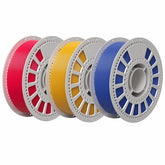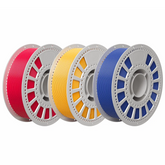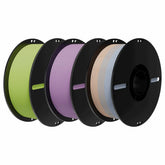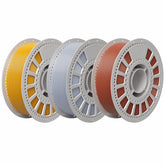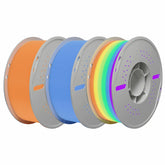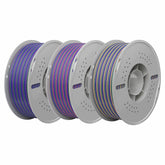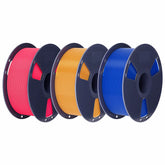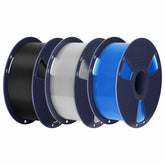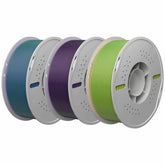The Complete Guide to Different Types of PLA Filament: What’s the Real Difference?
The Complete Guide to PLA 3D Printing Filaments: Understanding the Differences Between Various PLA Types
Have you ever walked into a store to buy 3D printing filament, only to be overwhelmed by the myriad of PLA options? PLA (Polylactic Acid) stands out as one of the most popular choices. Known for its high printing precision, ease of use, and eco-friendly biodegradable properties, PLA has become a go-to material for both beginners and professionals. However, from regular PLA to PLA+, PLA SILK, and PLA GLOW, it can be confusing. While they all carry the "PLA" name, they differ in performance and price. What are the differences between these members of the PLA family? Let's take a closer look today!
Functional PLA Variants
1. PLA+: Enhanced Durability
PLA+ is an FDA-certified 3D printing material made from renewable plant-based raw materials, making it both environmentally friendly and easy to print. The key advantage of PLA+ over standard PLA lies in its enhanced toughness. With an impact resistance that's 2-3 times higher than regular PLA, PLA+ is significantly less prone to breakage, making it ideal for functional parts that need to withstand stress.
2. PLA-CF: Carbon Fiber Reinforced
This filament is mixed with chopped carbon fiber, PLA-CF creates printed objects with a distinctive matte finish. This variant offers lightweight construction combined with excellent strength and improved heat resistance. However, it tends to be somewhat brittle and requires the use of wear-resistant nozzles during printing due to the abrasive nature of the carbon fibers.
3. PLA-HS: High-Speed Printing Specialist
PLA-HS features a specially formulated composition designed for high-speed printing applications. With enhanced melt flow properties, this material is perfect for high-volume, rapid printing while maintaining both strength and stability. It's commonly used in commercial batch model production, rapid prototyping, live demonstrations, and professional printing services.
4. PLA+HS: The Best of Both Worlds
Combining the enhanced toughness of PLA+ with high-speed printing capabilities, PLA+HS offers both printing efficiency and practical durability. This makes it particularly suitable for rapid production of functional components, medium-strength structural parts, and dual-purpose educational and engineering applications.
Aesthetic PLA Variants
1. PLA SILK: Luxurious Finish
PLA SILK creates objects with a silk-like smooth surface and vibrant colors that are significantly more lustrous than standard materials, effectively hiding layer lines for a premium finish.
- Dual-Color Effect: Different viewing angles reveal varying color presentations, with rotating models displaying beautiful dual-color gradients
- Tri-Color Variants: Rich horizontal color variations create stunning three-color gradients when the model is rotated

2. PLA GLOW: Illuminating Prints
PLA GLOW produces objects that absorb light from various sources (artificial lighting, sunlight, or UV light) and emit a glow in the dark. The brightness and duration of the glow effect depend on the intensity and exposure time of the light source – longer exposure times result in more pronounced nighttime luminescence.

3. PLA Matte: Sophisticated Texture
PLA matte is a specialized filament that produces surfaces with a distinctive matte finish. This effectively reduces gloss reflection, allowing printed objects to showcase finer details with a more sophisticated, non-reflective appearance.

Understanding the Purpose
Each PLA variant is engineered for specific needs and applications. Understanding these characteristic differences is crucial for maximizing the potential of your 3D printing projects and selecting the right material for your intended use case.
PLA Temperature Settings: The Golden Formula
Optimal Temperature Ranges:
- Nozzle Temperature: 190-230°C (refer to specific brand specifications for precise settings)
- Heated Bed Temperature: 50-60°C (refer to specific brand specifications for precise settings)
- Cooling Fan: 100% activation recommended
Troubleshooting Guide: Avoiding Common Pitfalls
Common Issues and Solutions:
- Severe Stringing → Reduce nozzle temperature by 5°C
- Poor Layer Adhesion → Increase nozzle temperature by 5°C
- Corner Warping → Apply adhesive spray to the heated bed
Conclusion
The world of PLA filaments offers a rich variety of options, each tailored to specific printing needs and aesthetic preferences. Whether you're looking for enhanced durability with PLA+, the striking visual appeal of PLA SILK, the functional benefits of carbon fiber reinforcement, or the novelty of glow-in-the-dark prints, there's a PLA variant designed to meet your requirements.
By understanding these differences and applying the proper printing parameters, you can unlock the full potential of each material type and achieve superior results in your 3D printing endeavors. Remember, successful 3D printing isn't just about having the right printer – it's about choosing the right material for your specific application and understanding how to optimize your settings for the best possible outcome.
